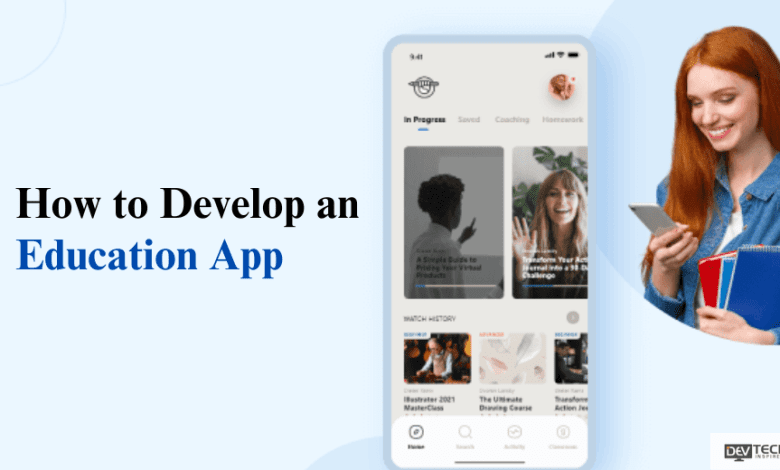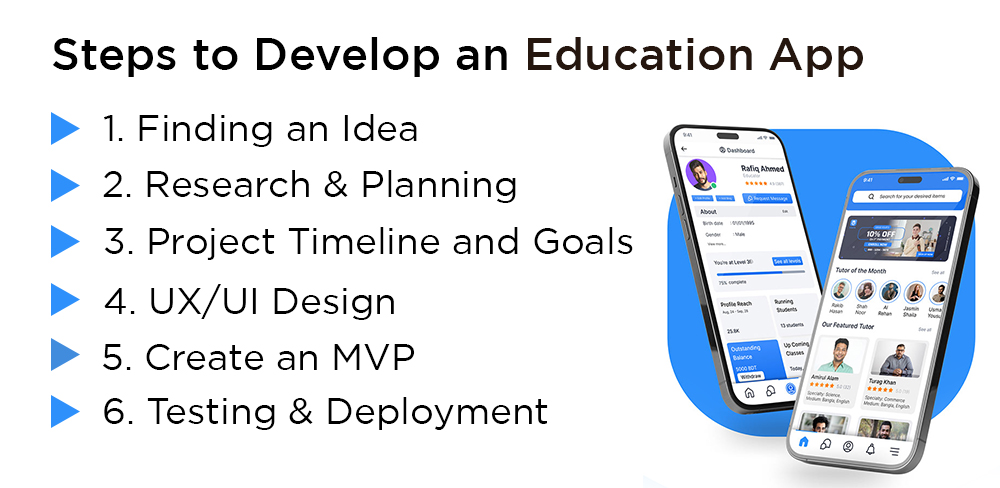How to Develop an Education App: Challenges and Opportunities

Are you looking to develop an education app for your business? If yes, then you must read this blog. The environment for learning is continuously changing, and the arrival of technology has significantly impacted how we learn.
The era of heavy books and lessons in schools is over. With the help of instructional apps, education may now be accessed with a few taps.
The worldwide U.S. market for education is expected to grow from its current worth of $1.2 trillion in 2021 to $1.5 trillion by 2028 at a CAGR of 4.3% during the forecast time frame of 2022–2028.
By looking at these stats, it is clear that the scope of the education industry is never going to stop. Additionally, it has opened the gate for many startups and entrepreneurs to invest in education app development.
But when developing an education, businesses may come up with new challenges along with opportunities. Therefore, this blog will explore the potential challenges and opportunities to develop an education app.
So, let’s begin.
What is an Education App?
An education app is an app that facilitates learning and educational activities. Apps like these are designed for smartphones, tablets, and computers, and they are meant to support and enhance the educational process.
Education apps are available for a variety of learners, from preschoolers to adults, and can cover a range of subjects and skills.
From math tutors for tykes to professional development platforms for adults, the possibilities are endless. So, if you are planning to invest in education app development, then you must hire dedicated developers who can build with the latest technology.
Challenges of Investing in an Education App
As per the eLearning app development company, below are the potential challenges businesses might face while creating an education app. So let’s have a look at them:
1. A Competitive Market:
The market for education technology is extremely competitive, with many players competing to gain market share. New companies find it challenging to compete with existing businesses and innovative startups. Investors should carefully consider how their app can differentiate itself from others and offer unique value to its users.
2. Quality and Relevance:
Maintaining high-quality and current educational content is essential for the success and growth of an app. It can be a challenge to ensure that content is relevant, engaging, and in line with curriculum standards. Investors must allocate resources for updating and improving the content of an app to meet changing educational requirements.
3. User Retention and Engagement:
Retaining customers over the long term can be difficult, especially in education, where the needs of users may change. En özel ve reel kızlar Taksim Escort Kadınlar Burada | İstanbul Escort Bayan sizleri bu platformda bekliyor. Investors need to devise strategies that keep users engaged.
For example, they are incorporating social features, gamification, and personalization. It is also important to address user reviews and continually enhance the user experience.
4. Monetization strategy:
It is important to develop a sustainable monetization plan. Some education apps use a freemium-style model that includes premium features.
Others may rely on advertising, subscriptions, or one-time payments. Investors must carefully evaluate the target audience and the market dynamics in order to determine the best monetization strategy and pricing structure.
5. Compliance and Regulatory Challenges:
Education apps are often needed to adhere to various regulations. This is especially true if the app caters to segments such as K-12 education or higher education.
It can be difficult and expensive to navigate data privacy laws, educational standards, and accessibility requirements. To avoid legal issues, investors should allocate resources to legal and compliance concerns.
6. Scalability and Technological Infrastructure:
As an educational app grows in popularity, its technical infrastructure must be scaled to meet the needs of a growing user base.
It is difficult to maintain server stability and security while maintaining a smooth user experience in times of high demand. To avoid downtime, investors must plan for scalability and invest in a robust infrastructure.
What Are the Opportunities in Education App Development?
In this section, we will discuss the opportunities for businesses to invest in education app development. So let’s have a look:
- Global reach:
Educational apps can be used to reach an audience worldwide which overcomes geographical barriers.
- Personalized learning:
You must create applications that cater to the individual needs of students.
- Delivering Content:
Create apps to deliver content, allowing educators to share videos, interactive lessons, and resources.
Read This: The Role of Technology in Online Education
- Online tutoring:
Develop platforms to connect students with teachers and tutors.
- Skill development:
You should know that when you develop an education app it focuses on skill development, offering courses and certificates in different fields.
- Gamification:
You must incorporate gamification elements into learning to make it fun and engaging. This will promote active participation.
- Analytics & Insights:
Create apps that offer data analytics and insights for educators to track student progress, and adjust teaching methods.
- Parent Teacher Communication:
Create apps to facilitate communication between teachers and parents, keeping them updated about student performance.
Steps to Develop an Education App


In this section, we will discuss the step-by-step process to develop an education app. But it can be quite daunting to build on your own. So, it is advisable to get help from a mobile app development company.
Step 1 Finding an Idea:
Let’s begin with the idea. Various entrepreneurs and startups make the mistake of thinking that an idea will be enough to impress their target audience. It’s not the case: your idea is just one part of the process.
You need to think carefully about the educational apps you wish to create, as there are already more than 52K+ on the market. Follow the below strategy to make your solution stand out.
Step 2 Research & Planning:
Market research is the next step. You should study your target market and your competitors. You may utilize these questions for assistance—for example, their demographic, job, interests, pain points, etc.
Step 3 Project Timeline and Goals:
After your research, you can begin the planning phase. Delegating this task to an agency or your internal development team is the best option. You can get information on possible deadlines, the number of specialists, and other resources required.
However, if you are seeking a team, then you must consult with an education app development company. They would provide you with an estimate and help you refine your idea.
Step 4 UX/UI Design:
The next step to develop an education app is to design the UI/UX design. You must be specific about the user interface, especially if it is an educational app. It should be easy to understand and intuitive for even the youngest children.
We recommend creating a prototype or a draft version of your app to ensure that it looks and feels the way you want. This will enable you to fix any errors that may have occurred without incurring additional costs.
Step 5 Create an MVP:
The minimum viable product is the first version of your application with only core functions implemented. The MVP is a test version that helps you determine if your app will be useful to users.
If the feedback is positive, you can continue to add features and build a complete product. If it’s negative feedback, you gather it, analyze and adjust your MVP.
Step 6 Testing & Deployment:
Testing and launching the application is the last step. You can use both automated and manual tests to make sure your learning platform makes a great first impression. You may deploy the education app on respective platforms.
However, it’s also important to continue supporting your app even after its release. Listen to your users and fix any bugs as soon as possible. This will assist you in keeping a good interaction with those who are watching.
Conclusion
The educational app industry is one of the fastest growing industries with a huge business potential and a large social incentive. It is an honorable cause to make quality education accessible to all eager learners from around the globe.
After getting well-informed about education app development and its challenges, you should now implement your ideas into reality. Hire an experienced company that can create an app that will help students learn while having fun.






